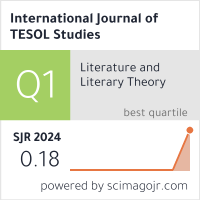2632-6779 (Print)
2633-6898 (Online)


Scopus
Ulrich’s Periodicals Directory (ProQuest)
MLA International Bibliography
MLA Directory of Periodicals
Directory of Open Access Journals (DOAJ)
QOAM (Quality Open Access Market)
British National Bibliography
WAC Clearinghouse Journal Listings
EBSCO Education
ICI Journals Master List
ERIH PLUS
CNKI Scholar
Gale-Cengage
WorldCat
Crossref
Baidu Scholar
British Library
J-Gate
ROAD
BASE
Publons
Google Scholar
Semantic Scholar
ORE Directory
TIRF
China National Center for Philosophy and Social Sciences Documentation
Rosa Mª Jiménez-Catalán
University of La Rioja, Spain
Abstract
This study has two objectives. The first is to ascertain whether there exists a relationship between the level of productive vocabulary and lexical availability in English as a foreign language. The second is to explore the depth of productive lexical knowledge through qualitative analysis of the level of words generated by upper secondary EFL learners. The measurement instruments were a Productive Vocabulary Levels Test (PVLT) and a lexical availability task, with eight semantic categories that served as prompts to activate word production. In the present study we analysed two traditional (SCHOOL, ANIMALS) and two non-traditional (TRAIN, FREE) semantic categories. We aimed to determine whether lexical availability and productive vocabulary are two closely related dimensions. The results show a significant positive correlation between the production of words generated in the lexical availability task and the scores obtained in PVLT. Furthermore, the qualitative analysis of the data indicates that the words generated by two groups of EFL learners correspond predominantly to the level of the 1,000 and 2,000 most frequent words in English.
Keywords
Lexical availability, productive vocabulary level, PVLT, EFL learners, word level